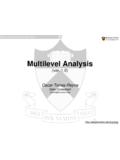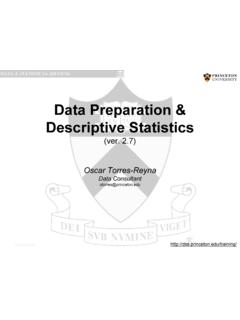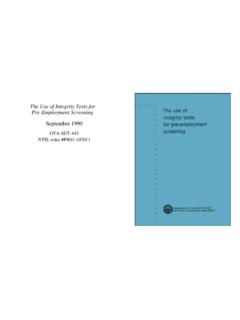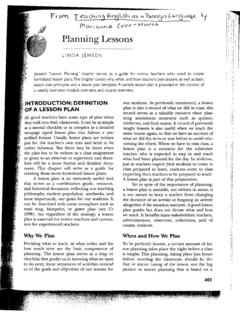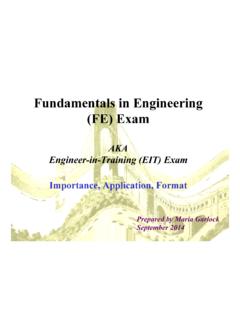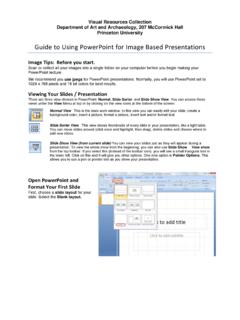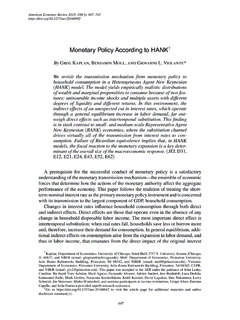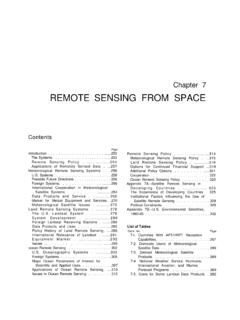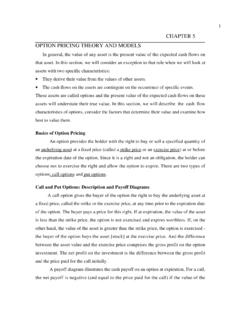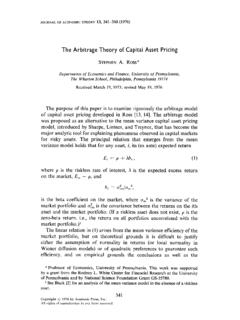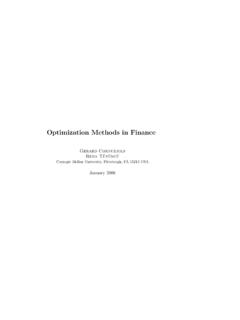Transcription of 10b Multiperiod Options - Princeton University
1 Fin 501:Asset pricing IFin 501:Asset pricing ILecture 10: MultiLecture 10: Multi--period Modelperiod ModelLecture 10: MultiLecture 10: Multiperiod Modelperiod ModelOptions Options BlackBlack--ScholesScholes--Merton modelMerton modelProf. Markus K. BrunnermeierProf. Markus K. Brunnermeier1 Fin 501:Asset pricing IFin 501:Asset pricing IBinomialBinomialOptionPricingOptionPric ingBinomial Binomial Option PricingOption pricing Consider a European call option maturing at time T ihikKC(SK0)hfliwith strike K: CT=max(ST K,0), no cash flows in betweenNtblttti llli tthiffijt Not able to statically replicate this payoff using just the stock and risk free bond Needtodynamicallyhedgerequiredstock Need to dynamically hedge required stock position changes for each period until maturity statichedgeforforwardusingput callparitystatic hedge for forward, using putcall parity Replication strategy depends on specified random process of stock price need to know how price pppevolves over time.
2 Binomial (Cox Ross Rubinstein) model is canonicalFin 501:Asset pricing IFin 501:Asset pricing IAssumptionsAssumptionsAssumptionsAssump tions Assumptions:St khi hdi id d Stock which pays no dividend Over each period of time, stock price moves from S to either uS or dS, over time, so that final distribution of STis binomialbinomialuSS Supposelengthofperiodishandrisk freerateisgivenbydSSuppose length of period is h and riskfree rate is given byR = erh No arbitrage : u > R > d Note:simplisticmodelbutaswewillseewithen oughNote: simplistic model, but as we will see, with enough periods begins to look more realisticFin 501:Asset pricing IFin 501:Asset pricing IAOneAOne PeriodBinomialTreePeriodBinomialTreeA OneA One Period Binomial TreePeriod Binomial Tree Example of a single period model S=50, u = 2, d= , R= What is value of a European call option with K=50?
3 Option payoff: max(ST K,0)50500C = ? Use replication to price0 Fin 501:Asset pricing IFin 501:Asset pricing ISingleSingle periodreplicationperiodreplicationSingle Singleperiod replicationperiod replication Consider a long position of in the stock and B dollars in bond Payoff from portfolio: uS+RB=100 + dS+RB=25 +1 25B S+B=50 +B Define Cuas option payoff in up state and Cdas dS+RB25 + payoff in down state (Cu=50,Cd=0 here) Replicating strategy must match payoffs:Cu= uS+RBCd= dS+RBFin 501:Asset pricing IFin 501:Asset pricing ISingleSingle periodreplicationperiodreplicationSingle Single period replicationperiod replication Solving these equations yields:CC )(dCuCduSCCdu = Inpreviousexample =2/3andB= 13 33sotheoption)(duRdCuCBud =In previous example, =2/3 and B= , so the option value isC = S+B = 20 Interpretation of : sensitivity of call price to a change in the stock price.
4 Equivalently, tells you how to hedge risk ofoptionof option To hedge a long position in call, short shares of stockFin 501:Asset pricing IFin 501:Asset pricing IRiskRisk neutralprobabilitiesneutralprobabilities RiskRisk neutral probabilitiesneutral probabilities Substituting and B from into formula for C, + =udduRdRduRdCuCSduSCCC1)()( Definep=(R d)/(u d)notethat1 p=(u R)/(u d)so + =duCduRuCdudRR1 Define p = (Rd)/(ud), note that 1p = (uR)/(ud), so[]duCppCRC)1(1 += Interpretation of p: probability the stock goes to uS in world where everyone is risk neutralFin 501:Asset pricing IFin 501:Asset pricing IRiskRisk neutralprobabilitiesneutralprobabilities RiskRiskneutral probabilitiesneutral probabilities Note that p is the probability that would justify the kiSiiklldcurrent stock price S in a risk neutral world:[]dSqquSRS +=)1(1pdudRqR= = No arbitrage requires u > R > d as claimed before Note:didn tneedtoknowanythingaboutthe Note: didn t need to know anything about the objective probability of stock going up or down (P measure).
5 Just need a model of stock prices to construct Q measure and price the 501:Asset pricing IFin 501:Asset pricing ITheThebinomialbinomialformulainagraphfo rmulainagraphThe The binomial binomial formula in a graphformula in a graphFin 501:Asset pricing IFin 501:Asset pricing ITwoTwo periodbinomialtreeperiodbinomialtreeTwoT woperiod binomial treeperiod binomial tree Concatenation of single period trees:u2 SuSSudSdSd2 SFin 501:Asset pricing IFin 501:Asset pricing ITwoTwo periodbinomialtreeperiodbinomialtreeTwoT woperiod binomial treeperiod binomial tree Example: S=50, u=2, d= , R= 5 Option 501:Asset pricing IFin 501:Asset pricing ITwoTwo periodbinomialtreeperiodbinomialtreeTwoT woperiod binomial treeperiod binomial tree To price the option, work backwards from final Weknowhowtopricethisfrombefore:10020050C u1500 We know how to price this from = =dudRp Three step procedure:[]60)1(1= +=uduuuCppCRCpp 1.
6 Compute risk neutral probability, p 2. Plug into formula for C at each node to for prices, going backwards from the final node. 3. Plug into formula for and B at each node for replicating strategy, going backwards from the final 501:Asset pricing IFin 501:Asset pricing ITwoTwo periodbinomialtreeperiodbinomialtreeTwoT woperiod binomial treeperiod binomial tree General formulas for two period tree: p=(Rd)/(ud)Cuu p=(R d)/(u d)Cu=[pCuu+(1 p)Cud]/R =(CC)/(u2 SudS)uu u=(Cuu Cud)/(u2S udS)Bu=Cu uSC=[pCu+(1 p)Cd]/RCCd=[pCud+(1 p)Cdd]/R d=(Cud Cdd)/(udS d2S)=[p2 Cuu+2p(1 p)Cud+(1 p)2 Cud]/R =(Cu Cd)/(uS dS)B=C SCud Syntheticoptionrequiresdynamichedgingd(u ddd)()Bd=Cd dSCdd Synthetic option requires dynamic hedging Must change the portfolio as stock price movesddFin 501:Asset pricing IFin 501.
7 Asset pricing IArbitragingamispricedoptionArbitraginga mispricedoptionArbitraging a mispriced optionArbitraging a mispriced option Consider a 3 period tree with S=80, K=80, u= , d= , R= Implies p = (R d)/(u d) = Can dynamically replicate this option using 3 period binomial tree. Turns out that the cost is $ If the call is selling for $36, how to arbitrage ? Sell the real call Buy the synthetic call What do you get up front?C SB3634 08192 C S+B = 36 = 501:Asset pricing IFin 501:Asset pricing IArbitragingamispricedoptionArbitraginga mispricedoptionArbitraging a mispriced optionArbitraging a mispriced option Suppose that one period goes by (2 periods from expiration), and now S=120.
8 If you close your position, what do you get in the following scenarios?Cllil h i ll $60 0 Call price equals theoretical value , $ Call price is less than 50 Call price is more than Answer: Closingthepositionyieldszeroifcallequals theoreticalClosing the position yields zero if call equals theoretical If call price is less than , closing position yields more than zero since it is cheaper to buy back call. If call price is more than , closing out position yields a loss! What do you do? (Rebalance and wait.)Fin 501:Asset pricing IFin 501:Asset pricing ITowardsBlackTowardsBlack ScholesScholesTowards BlackTowards BlackScholesScholes Black Scholes can be viewed as the limit of a binomial tree where the number of periods ngoes to infinity Takeparameters Take parameters: Where:nTnTeudeu///1, === Where: n = number of periods in tree T = time to expiration ( , measured in years) = standard deviation of continuously compounded return Alsotake Also takenrTeR/=Fin 501:Asset pricing IFin 501.
9 Asset pricing ITowardsBlackTowardsBlack ScholesScholesTowards BlackTowards BlackScholesScholes General binomial formula for a European call on non dividend ppaying stock n periods from expiration: = njnjjnjKSduppnC),0max()1(!1 SubstituteudandRandlettingnbeverylarge(h andwaving =jKSduppjnjRC0),0max()1()!(! Substitute u, d, and R and letting n be very large (hand waving here), get Black Scholes:()()dNKedSNCrT =21()()()()[]TrKSTd ++=212//ln1 Tdd =12 Fin 501:Asset pricing IFin 501:Asset pricing IInterpretingBlackInterpretingBlack ScholesScholesInterpreting BlackInterpreting BlackScholesScholes Note that interpret the trading strategy under the BS formula as()()21dNKeBdNrTllcall == Price of a put option.)
10 Use put call parity for non dividend paying stock()2dNKeBcallKeSCPrT+ = stock() ()12dSNdNKeKeSCPrT =+ = Reminder of parameters 5 parameters S= current stock price, K= strike, T= time to maturity, r= annualized continuously compounded risk free rate, =annualized standard dev. of cont. compounded rate of return on underlyingFin 501:Asset pricing IFin 501:Asset pricing IInterpretingBlackInterpretingBlack ScholesScholesInterpreting BlackInterpreting BlackScholesScholes Option has intrinsic value[max(S K,0)] and time value[C max(S K,0) ]4550303540202530 Time ValueIntrinsic 501:Asset pricing IFin 501:Asset pricing IDeltaDeltaDeltaDelta Recall that is the sensitivity of option price to a small change in the stock price Number of shares needed to make a synthetic call Alsomeasuresriskinessofanoptionposition Also measures riskiness of an option position From the formula for a call,()1dNll= ()()21dNKeBdNrTcallcall = A call always has delta between 0 and 1.
